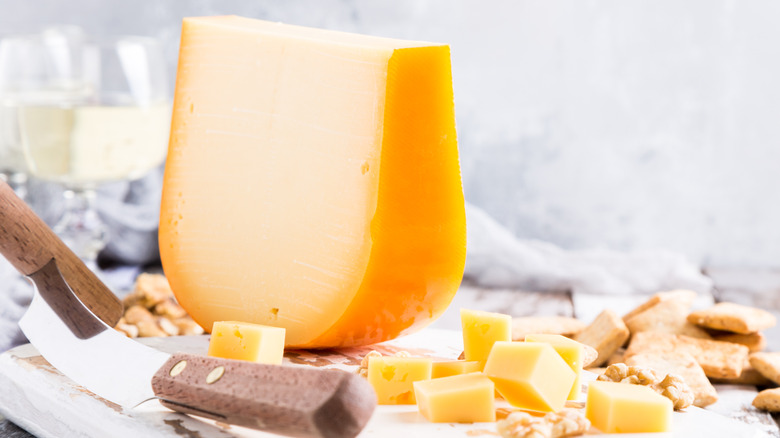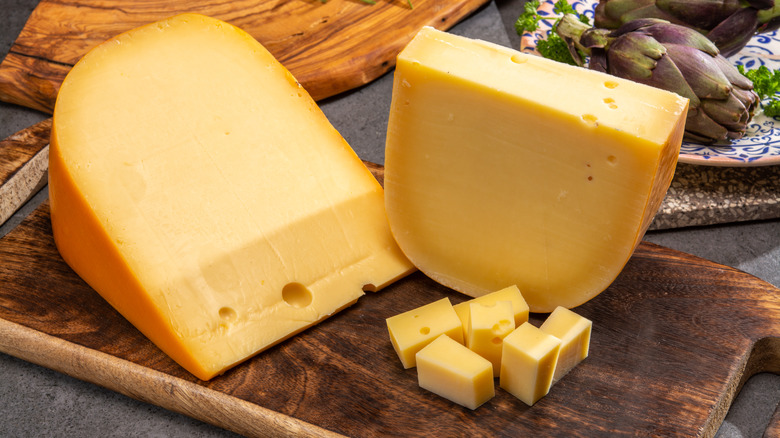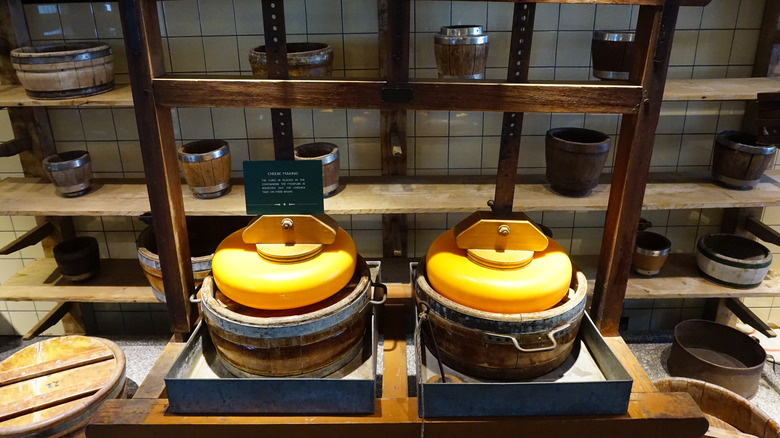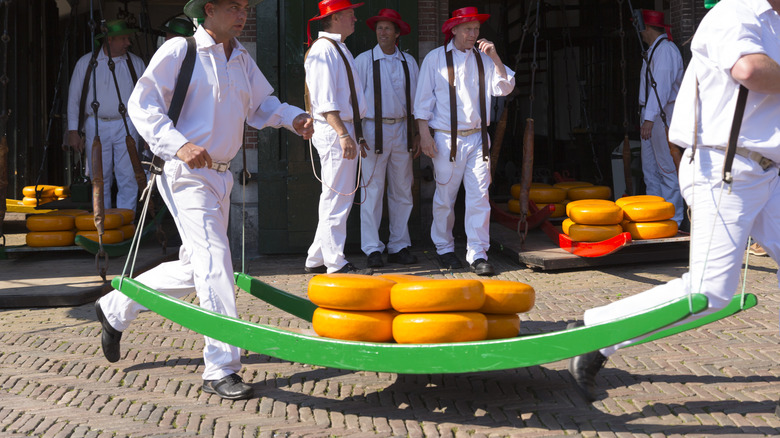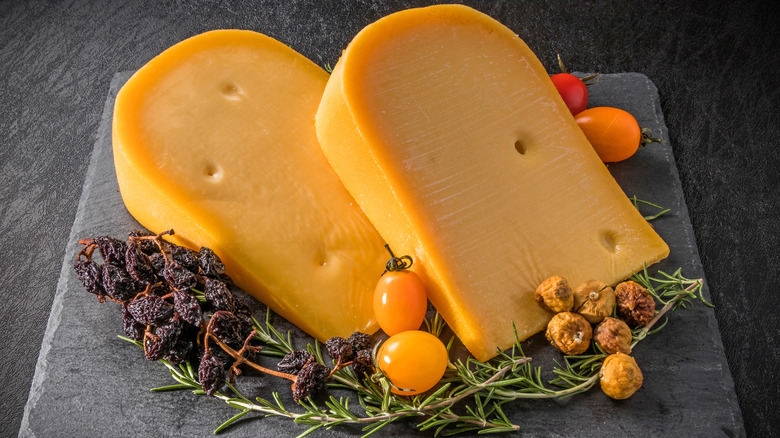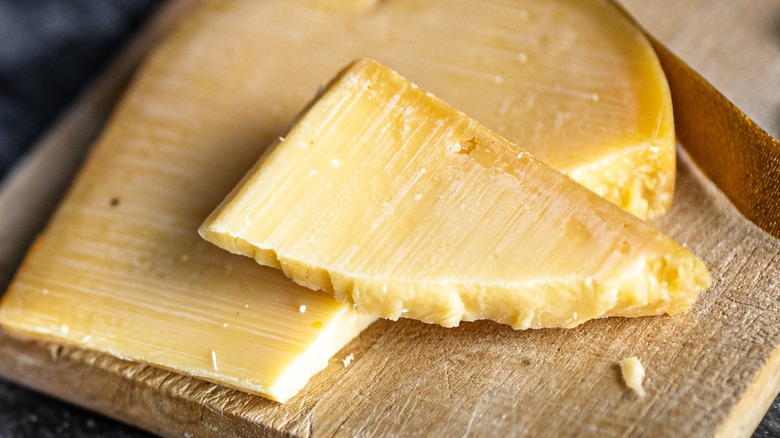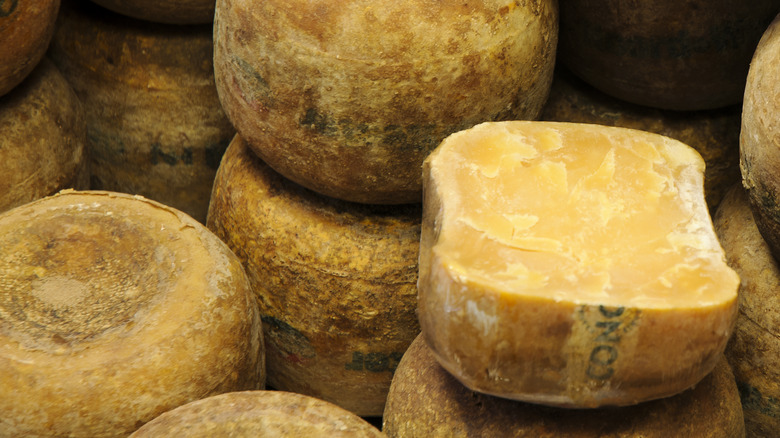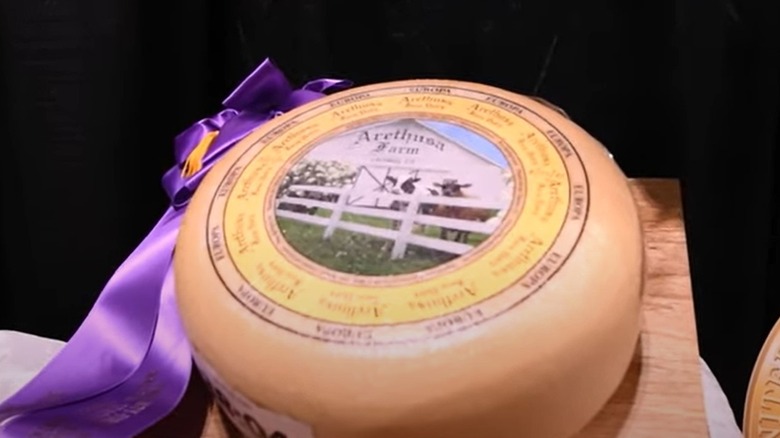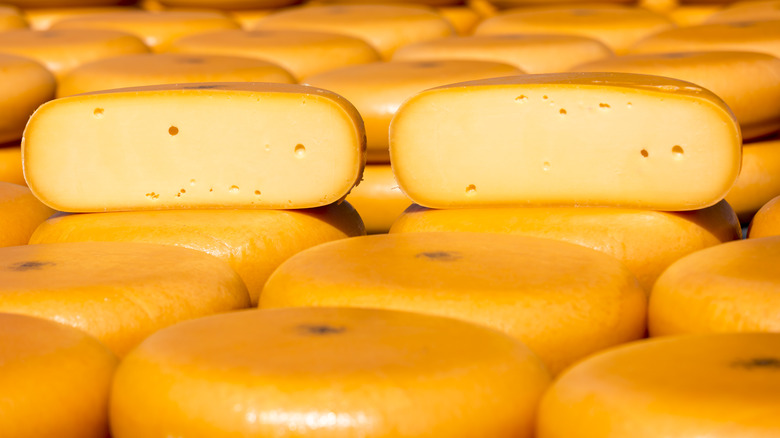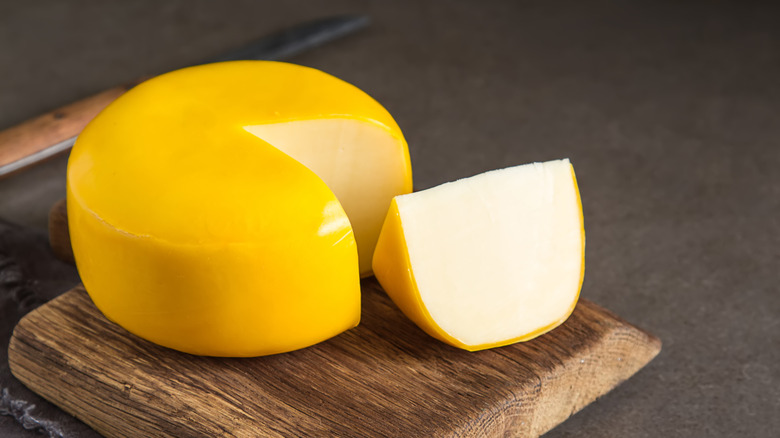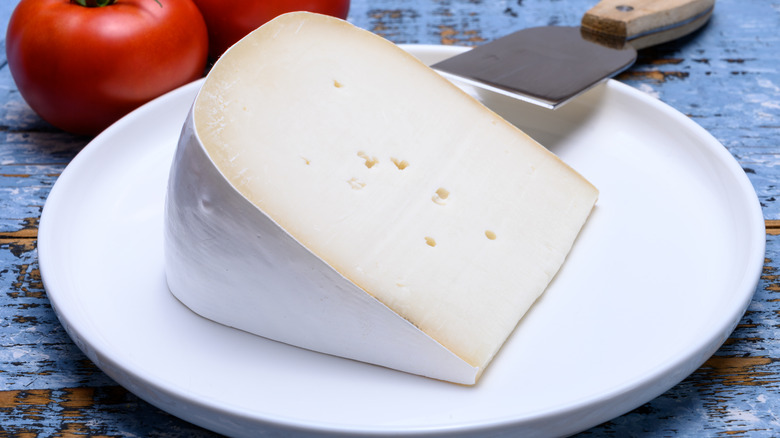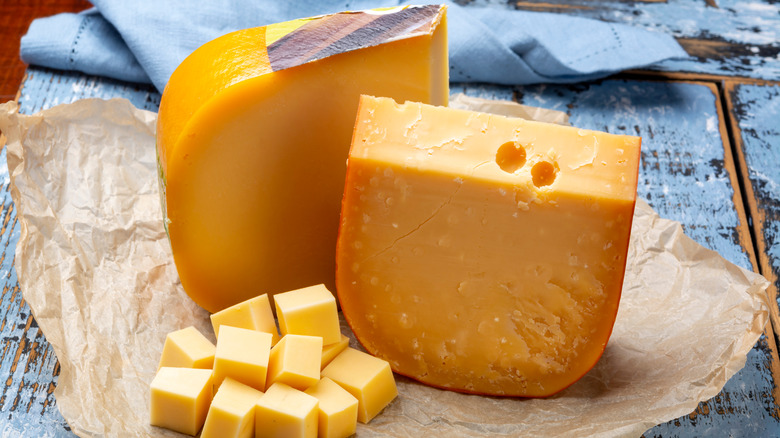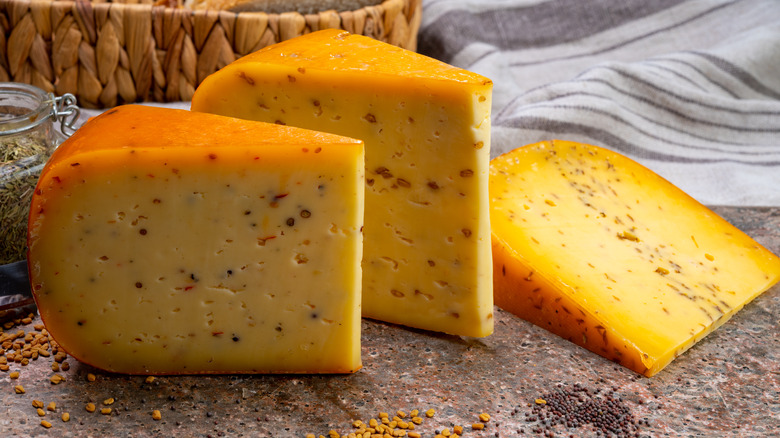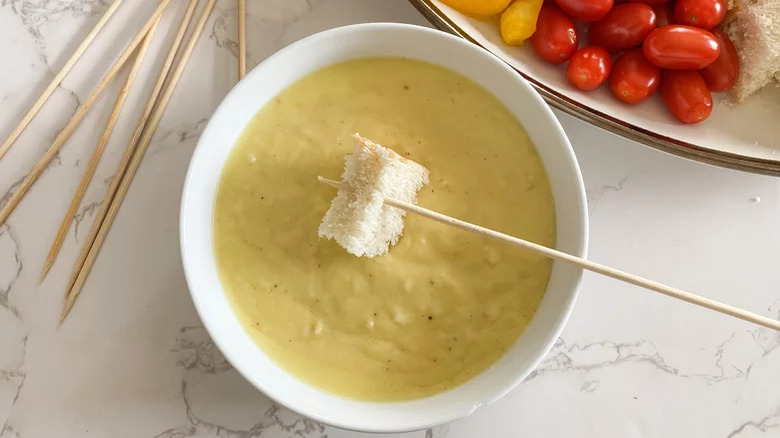The Ultimate Guide To Gouda Cheese
It's easy to see why Gouda is one of the most loved cheeses on the planet. With its sweet taste, unique texture, and versatile nature, it deserves to be widely enjoyed. While it always tastes great sliced and eaten at the end of a meal, this cheese is also wonderful when it's been added to recipes. Try using Gouda to make an easy yet delicious cheese sauce or a classic British teatime meal of cheese and beans on toast. Or let it melt into our grilled Buffalo chicken mac and cheese sandwich for a taste of U.S. comfort food. Depending on how you use it, Gouda can be an everyday cheese and also a sophisticated award-winner.
But there's more to this cheese than flavor. It's also got plenty of history and science to it. For instance, did you know that this famed Dutch cheese isn't necessarily Dutch? And what makes a specific cheese Gouda? It's time to learn how the taste and texture of Gouda have changed over its centuries of existence. Here's your ultimate guide to Gouda cheese.
Gouda is a ripened and semihard cheese
Gouda is a semi-hard cheese that's ripened for various amounts of time. While not every modern Gouda is from the Netherlands, there are Dutch Gouda cheeses you may have heard of. The Dutch Beemester is darker in color than a lot of other varieties and has a creamy taste and texture. The producers put this down to the nutrients in the pastures that come from clay-rich soil. Varieties include wheels flavored with truffle and garlic and one that's won gold several times at the World Cheese Awards.
Old Amsterdam is another popular brand that's made in Holland, although it was actually established in the 1980s. The smooth texture of its aged Gouda, compared to many mature kinds of cheese, is a particular point of pride for its makers.
There's plenty of room for variety, as Gouda isn't always made using the same type of milk, and it's not left to age for the same amount of time, either. As a result, the taste and texture can vary significantly
It's made in a specific way
We're not about to give you a whole lesson in cheesemaking, but you should at least know that cheese is made from pressed curds made from milk. Gouda is no different. However, what happens to the curds before they're pressed is what truly defines a Gouda.
When making Gouda, the curds are rinsed, which gets rid of the whey and breaks down lactose. The water is also heated before being drained to dry the curds out. Cutting down on lactose means there's less lactic acid in Gouda and gives it a sweeter taste than other cheeses. Lactic acid creates a strong, tangy taste and since there's less of it Gouda doesn't have that distinctive cheese bite.
Once the curds have been rinsed, they're pressed into a distinct round shape that makes Gouda so recognizable. This isn't the end of the process, as the wheel is then submerged in brine for 12 hours to several days. It's then dried and coated.
Gouda cheese isn't made in Gouda
There is a city in the Netherlands called Gouda that's known as a cheese-making center. However, not all Gouda cheese is made here, though the heritage of Gouda is still all about cheese that's produced here to this day. But Gouda can be made elsewhere, too. That's why there are Gouda cheese producers in non-Dutch nations like the U.S., many of which have attracted international recognition for their products.
In other words, Gouda made outside of the city of Gouda shouldn't be seen as inferior. Of course, there are still traditional producers in its namesake city, but what really makes Gouda is how it's produced.
It isn't just Gouda cheese that this city is famed for, either. In fact, about 60% of the country's cheeses are produced in and around the city, including varieties such as Edam. Still, there's value in the history here, and even today you can buy wheels of Gouda in the central square just as you could in the past.
It's one of the oldest cheeses in Europe
At the end of the 14th century, Gouda became the epicenter of cheese-selling in the Netherlands. It was from here that Gouda cheese was born. However, Gouda from this part of the world could have been first produced way back in the 12th century. This doesn't make it merely old, but may mark Gouda as one of Europe's oldest cheeses.
The city of Gouda is still home to a famous cheese market. Centuries ago, it was here that producers and traders would gather from across the Netherlands and beyond. The type of cheese that was found in Gouda inevitably became known as Gouda today and it became one of the main cheeses in the Netherlands. There are differences between different Goudas but how it's made hasn't changed for hundreds of years. Next time you bite into a slice of Gouda, imagine cheesemakers nearly a thousand years ago making this type of cheese. Today's Gouda is a great legacy of its long history.
The taste can be mellow to strong
Describing the taste of Gouda isn't straightforward, as the exact notes depend on the age of the cheese, the type of milk used, where ingredients are sourced, and flavorings such as herbs and spices. How you store the cheese as well as how you cook and cut it also impacts the taste. Young Gouda can taste fairly plain with just a hint of nutty sweetness. However, as it ages, Gouda can become saltier and more intense. Aged Gouda can taste almost like toffee with a sometimes powerful nutty flavor.
As well as some sweetness, aging can add more tartness, while many varieties of Gouda also taste rich and creamy. But how to use each sort? If you're adding Gouda to a sandwich you might prefer a softer, sweeter cheese. If you're melting it and want a more robust character, an older Gouda is a better choice. Consider how you'll pair your cheese as well. For something served at a kids' party, for instance, you will likely want a milder variety. If you're serving Gouda with a dessert or with some fruity chutneys, then a less-sweet cheese that's got a strong flavor will offer a better balance of flavor.
The texture ranges from spongy to crumbly
A young Gouda that hasn't had a chance to age much tends to have a softer texture than if it's been sitting around for a while. In fact, it's this springy characteristic that defines a Gouda for most people. It's fairly dense, so it can feel almost rubbery and bendy, unlike a more brittle and crumbly Parmesan.
Yet, not all Gouda has this spongy texture. Throughout the aging process, the cheese becomes harder. There's less moisture in these aged varieties and so there's less bounce in them. This isn't a negative, however. A well-aged Gouda that's colored a little and crumbles can taste amazing on a cracker.
You may have noticed that other cheeses, such as Parmesan, can crystalize. It's this process that also changes she's Gouda's texture and gives it a grainier appearance and texture. Next time you go shopping for some Gouda, try ones at opposite ends of the aging process to see which variety you prefer. If you love the almost chewy sensation of Gouda then select a younger type. if you prefer a cheese that's almost craggy, opt for one that's at least a year old.
Dutch Gouda comes in six age categories
You might have come across Gouda that's described as young or aged, which refers to how long the cheese is left to mature. Once it's sealed in a wheel and covered with a rind, it can be good to eat from just a month to over a year. The Dutch classify Gouda into at least six categories based on age.
Aged Gouda must be over 12 months old, while fully matured Gouda is between 10-12 months. If you like Gouda that's extra-matured then it'll have to have been aging for 7-8 months. Matured Gouda is aged 16-18 weeks and below this is young matured Gouda and young Gouda.
The more aged varieties are harder and the color is deeper and more orange than the pale yellow of a young Gouda. If you have some idea of the age of a Gouda then you can choose the right cheese for your palate and occasion. An aged Gouda might be wonderfully fanned out on a cheeseboard but if you need more to make our mac and cheese, then you will probably want a younger and more pliable variety of Gouda.
A Gouda won a 2023 US cheese award
The United States Championship Cheese Contest attracts thousands of entries from across the country. In 2023, the Champion Cheese was an aged Gouda produced in Connecticut, which earned close to a perfect score. The winner, known as Europa, is made at Arethusa Farm Dairy in Bantam. The company suggests pairing the 6-12 month aged cheese with either a brown ale or a Scotch whisky, which should pair beautifully with its savory, nutty flavor that carries a hint of butterscotch.
With more than a million cows in the state, Wisconsin is widely known as the cheese capital of the U.S. and produces around 26% of the nation's cheese. Close to 90% of the milk from this part of the country is used to make cheese, not only for production in Wisconsin but across the world.
The state is home to award-winning Gouda producers, too. Marieke Gouda won accolades in the same championship for a young and a mature Gouda, as well as awards for a smoked variety and black pepper and fenugreek-flavored cheeses. Meanwhile, Door Artisan Cheese Company won for its aged Gouda, Roth Cheese produced a winning hot honey variety, and Arla Foods won attention with a smoked Gouda.
Only one type of Gouda is protected
There's a long list of foods that are protected, which typically means that they can only use a given name when they're produced in a certain place or region, and often in a particular way. For example, Champagne isn't just the name of any bubbly celebratory drink. Instead, it must be produced in the Champagne region of France to rightfully earn that name. In Europe, Parmesan can only be called that if it's Parmigiano Reggiano and comes with a Protected Designation of Origin (PDO).
Yet, even though the Netherlands and the city of Gouda have a long history of cheesemaking, the Gouda name is not universally protected. If you buy a Gouda it could have been produced in the U.S. or anywhere else in the world. However, Gouda Holland has had PGI protection since 2006 which means part of the production has to have happened in the country. In this case, the milk must come from the Netherlands.
In 1996, PDO protection was granted to Noord-Hollandse Gouda. This means that every part of the production has to take place in Noord-Holland Province. If you want to try Gouda that's from this area, look for the designation stamps on the packaging or even on the cheese itself.
It's got two rinds and comes in many sizes
You can tell a lot about cheese from its rind. Gouda is created in the shape of wheels that are fairly flat rather than bulbous. You probably know the smallest Gouda because you've no doubt thrown it in your lunchbox in the form of a cute Babybel round. There's something so satisfying about peeling off that thick red wax and biting into the soft and bouncy creamy round of cheese.
Producers also make small wheels of Gouda that can weigh between 10-20 ounces. Larger wheels of between 10-12 pounds are the usual weight of a traditional Gouda.
A Gouda typically has two rinds. There's an outer one that can be red, yellow, or white, as well as orange. Mature Gouda often has a black rind. These are made from wax and stop the cheese from becoming dry. You might want to take this off before serving some Gouda triangles. Use a peeler or knife to remove it, though you may be able to peel it with your hands, too.
Underneath that waxy coating is another rind that is natural and therefore technically edible. It's pretty tough, though, and tastes a bit waxy so you might still want to cut this off or just avoid eating it. Grilling will also soften it. Smoked Gouda has a brown rind you can eat, but again it might be a bit chewy.
Not all Gouda is pasteurized and made from cow's milk
Most of the Gouda that is produced worldwide is made from pasteurized cow's milk. However, with so many different varieties and ages of this ultra-popular cheese out there, it comes as no big surprise to learn that there's variation here, too. Different sorts of milk do change the taste, of course. Meanwhile, it's also good to know what cheese is made from in case of any dietary restrictions. For instance, pregnant women will want to stay away from Boerenkaas Gouda, a yellow rind variety made by small-scale producers in the Netherlands from unpasteurized milk. While it's a common sight in Dutch households, this cheese is less often stocked at U.S. cheese counters.
Gouda can also be made from sheep's milk. The Fuzzy Udder Creamery in Maine produces this type of cheese with unpasteurized milk. The texture is less dense than regular Gouda but still delivers a classic Gouda toffee and nut taste. In California, the Central Coast Creamery makes Gouda with pasteurized goat's milk that is aged for five months. Smooth and sweet tasting, the cheese has some graininess like other aged varieties.
You can find crystals in aged Gouda
If you're a real cheese lover, then you're probably not going to have Gouda cheese around for long enough to worry about whether it's gone off or not. But it's always good to know how to store it, especially if you've invested in a huge piece. Aged Gouda doesn't necessarily have to be refrigerated, since it is drier and so fares better for longer periods out of the fridge. If you choose to store Gouda in the fridge, do so between 35-45 degrees Fahrenheit. If you cover it in plastic wrap, then it should last a few weeks. For best results, change the wrapping every few days and don't wrap too tightly.
While you're at it, write the date you acquired the cheese on that wrapper. There's nothing more frustrating than fumbling around and finding a block of cheese at the back of the fridge, only to not remember how long it's been there. As for mold, you can cut off any green fuzz. But white spots aren't mold or salt, even though they may be a bit crunchy. Instead, they're tyrosine and calcium lactate crystals that form as proteins and lactose break down in the cheese over time. It's quite common to see them on aged Gouda in particular. They're safe to eat when they appear on and in your Gouda, and indeed can be a sign that your cheese is aging well.
Some Gouda has extra ingredients
If you're used to grabbing a random block of Gouda without much thought, then it's time to slow down and explore all the incredible varieties out there. Besides factors like age, milk type, and whether or not it's been smoked, other ingredients can come along, too. That's because the texture and taste of Gouda are perfect for pairing with other ingredients. So, the next time you're cheese shopping, consider looking for a Gouda that has some extra goodies inside.
For a fabulous charcuterie board presented at an upscale party, try a Gouda with spices in the mix like one with cumin, which adds a delicately-spiced warmth that brings out the creaminess of a young cheese. Fenugreek also goes well with this variety, adding a tangy edge and pleasant bitterness.
It's not just about taste either, as herb and spice speckles in the cheese also look appetizing. And if you want to indulge, try Gouda filled with rich add-ins such as bacon or a variety with garlic, basil, and parsley.
Gouda is perfect for melting
There's nothing as divine as molten cheese that's hot, creamy, and rich with umami flavor. Melting Gouda brings out tastes that range from sweet and caramel to nutty and buttery. For a quick-fix melted cheese moment, there's nothing easier than some grilled cheese. Keep it simple, however, as this type of food doesn't improve with a whole stack of other ingredients.
If you want to be a little fancy, then you could make our cheese fondue. For this recipe, you combine grated Gouda with shredded Swiss cheese. brandy, white wine, and mustard. Now all you have to do is decide what to dip into the mix. We recommend classic cubes of bread and a selection of vegetables.
Not all cheeses work when they're heated, as some melt away while others don't melt at all. Gouda sits in the perfect middle ground. Being a good melter means that Gouda is fabulous in macaroni and cheese, perhaps with a smoked variety for velvety texture and strong taste. You can also add it to mashed potatoes to give this side a luxurious upgrade.
